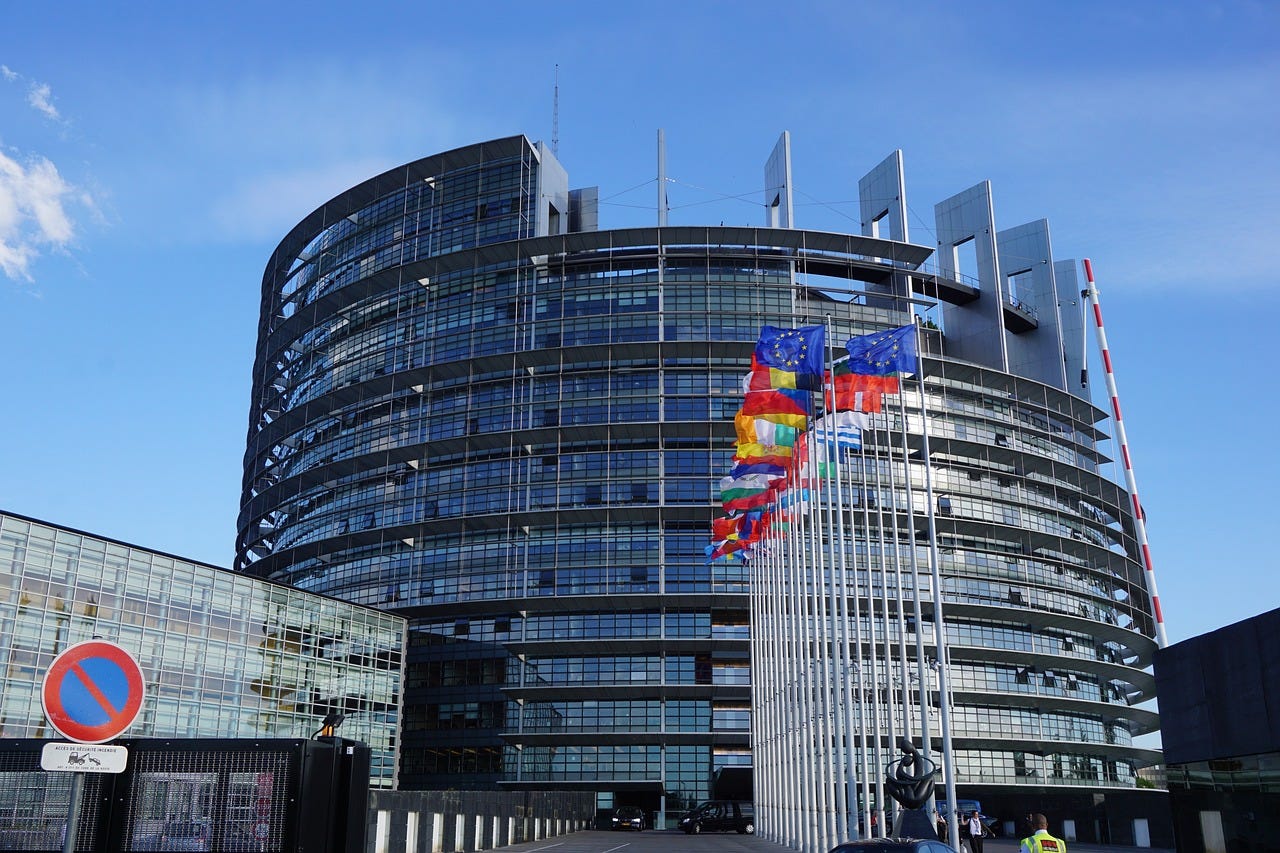Europe backs down on climate disclosure rules with two-year delay
Welcome to Callaway Climate Insights. Especially our new subscribers since the New Year. Please enjoy, and share with your colleagues.
Today’s edition is free. To read our insights and support our great climate finance journalism five days a week, subscribe now for full access.
The push by investors for more climate disclosure from companies, so controversial in the U.S., was hit with a setback in Europe this week as well after EU regulators delayed a new rule by two years for eight specific sectors, including oil and gas.
The delay until 2026 was designed to give companies in these sectors, also including mining, cars, textiles, energy production, and foreign companies, more time to work on a broader requirement to include climate risks in their annual reports. But it was seen as a climbdown in a region where rightwing political candidates are gearing up for elections this year by campaigning against extra energy costs and bureaucracy.
The UK’s Rishi Sunak is pushing through a new law to increase oil and gas drilling in the North Sea and has said that he would oppose any energy regulations that increase costs for voters, er, consumers. Backing down on the disclosure issue indicates that EU leaders are having similar issues keeping on top of climate disclosures.
The delay hurts Europe’s reputation as a leader in the fight against climate change, while providing cover for the Securities and Exchange Commission in the U.S., which has delayed its own climate disclosure rule for more than two years already in the face of widespread conservative opposition.
For investors looking to limit climate risk, it’s a frustrating setback at a time when those risks are becoming more and more apparent. . . .
Don’t forget to contact me directly if you have suggestions or ideas at dcallaway@callawayclimateinsights.com.
Follow us . . . .
Twitter | LinkedIn | Facebook | Instagram
How picking climate stocks with momentum strategies can backfire
. . . . Everyone knows that understanding how ESG indexes are put together can be confusing. Ratings of sustainable stocks are all over the place. But one strategy, involving choosing stocks with recent price momentum, has yielded a surprising outcome, according to new research explained by Mark Hulbert. And it goes to the heart of how two very popular index companies may be building their products, and possibly selling them.
Resolutions for 2024 for climate finance investors in Latin America
. . . . For climate investors, 2024 is either the year to look under rocks in Latin America for great values, or crawl under them in frustration. Veteran Latin American correspondent Mike Molinski gives investors his list of New Year’s resolutions for investors interested in climate plays in one of the world’s most volatile investment and political regions. . . .
Thursday’s subscriber insights

How the Ukraine war has impeded arctic climate research — and that of bothersome beavers
. . . . A curious side effect of the devastating war in Ukraine is that broken relations between the West and Russia are blocking scientists from gathering data and information about Russia’s giant frozen north.
The tracking of ice melt, wildfires under frozen bogs, and even the migration of bothersome beavers, who clog up streams and hurt water flow, has ground to a halt since Russia invaded Ukraine almost two years ago. Scientists are frustrated and say it’s impossible to draw up accurate assessments of Arctic climate with such a large component of the Arctic unreachable.
With the war showing no signs of ending, it looks like another winter and spring will pass without any movement, as Russia’s Vladimir Putin has other things on his mind. Read more here. . . .
Tesla’s Elon Musk plays the China card
. . . . Nobody is that surprised at what comes out of Elon Musk’s mouth anymore, but it was notable in the context of the coming U.S. election season that he was quick to play the China card on Tesla’s TSLA 0.00%↑ earnings call yesterday.
While predicting the leading U.S. electric car maker’s growth rate would slow this year, Musk said this would play into the hands of leading Chinese EV makers such as BYD without more trade barriers. BYD overtook Tesla last quarter as the world’s top EV producer and has already started selling its low-priced models in Europe.
With Tesla’s low-priced model at least a year away, Musk made it clear that price cuts and margin shrinkage wouldn’t be enough to turn Tesla around, especially with the pace of general EV demand slowing. The China relationship — especially the difference between how President Joe Biden and former president Donald Trump see it — will be a hot debate this election season; with Musk apparently fanning the flames.
Tesla’s shares were down as much as 12% Thursday after its earnings report, and despite Musk’s prediction that Chinese EV makers might “demolish” its rivals without more trade barriers, the selloff spread to Chinese EV stocks as well. . . .
Editor’s picks: Good news for penguins; plus, better news on clean energy generation

New penguin colonies found
Scientists studying satellite imagery have found four previously unknown colonies of emperor penguins along the edges of Antarctica, bringing the total number of known colonies to 66. It’s good news for an area endangered by climate change, reports Yale Environment 360. According to the report, the loss of sea ice has forced penguins around Antarctica to find new breeding grounds. Scientists from the British Antarctic survey were reviewing satellite images when they spotted the new colonies. Two clues helped: Emperor penguins are up to four feet tall, and, the report notes, “their voluminous brown excrement that stands out against the white snow.”
Clean energy generation could keep pace with demand
Clean sources of generation could cover all of the world’s anticipated additional electricity demand over the next three years, says the International Energy Agency. Global electricity demand is expected to grow at a faster rate over the next three years as the clean energy transition gathers speed, with all the additional demand forecast to be covered by technologies that produce low-emissions electricity, according to a new report from the IEA. Where’s the demand growth coming from? Electricity consumption from data centers, artificial intelligence and the cryptocurrency sector could double by 2026. Data centers’ total electricity consumption could reach more than 1000 TWh in 2026. This demand is roughly equivalent to the electricity consumption of Japan, the report says.
Explain that: No, it’s not the sun’s fault
. . . . Some people blame the Sun for climate change. But, says NASA, several lines of evidence show that current global warming cannot be explained by changes in energy from the Sun. These include:
Since 1750, the average amount of energy from the Sun either remained constant or decreased slightly.
If a more active Sun caused the warming, scientists would expect warmer temperatures in all layers of the atmosphere. Instead, they have observed a cooling in the upper atmosphere and a warming at the surface and lower parts of the atmosphere. That’s because greenhouse gasses are slowing heat loss from the lower atmosphere.
Climate models that include solar irradiance changes can’t reproduce the observed temperature trend over the past century or more without including a rise in greenhouse gasses.
The above graph compares global surface temperature changes (red line) and the Sun's energy that Earth receives (yellow line) in watts (units of energy) per square meter since 1880. The lighter/thinner lines show the yearly levels while the heavier/thicker lines show the 11-year average trends. Eleven-year averages are used to reduce the year-to-year natural noise in the data, making the underlying trends more obvious.
The amount of solar energy that Earth receives has followed the Sun’s natural 11-year cycle of small ups and downs with no net increase since 1880. Over the same period, global temperature has risen markedly. “It is therefore extremely unlikely that the Sun has caused the observed global temperature warming trend over the past half-century,” NASA scientists say. Source: Evidence Shows That Current Global Warming Cannot Be Explained by Solar Irradiance (NASA - Vital Signs of the Planet)
Words to live by . . . .
“There’s a lot … in environmentalism where it’s often pointing fingers, and I think that’s really ineffective at getting people to change. But change in yourself can often be really infectious and people get interested.” — Hannah Ritchie, deputy editor at Our World in Data and author of “Not the End of the World: How We Can Be the First Generation to Build a Sustainable Planet”.






